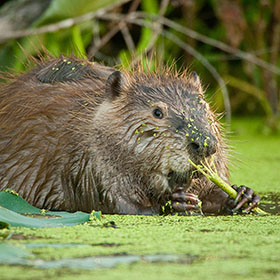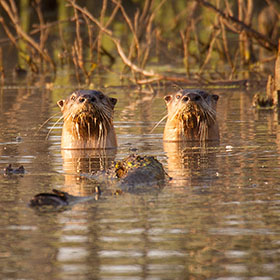
Note from Steve: Today I’m excited to introduce another new contributor to PhotoNaturalist: Jim Braswell. Jim is a great wildlife/landscape photographer from Missouri, and his first post is all about taking photos from a kayak! Enjoy!
Want to have some real fun? I was turned on to photographing wildlife from a kayak by a friend of mine a few years ago. After a lot of convincing (yes, I had a lot of concerns about taking my expensive camera equipment in a small vessel, over open water), we loaded up two kayaks and headed out to photograph at a Conservation Area. After a day of photographing American white pelicans at pretty close range, I fell in love with the thrill of kayaking the backwaters, where human intervention is rare and the wildlife abundant.
So, then I purchased my own kayak and have since been out hundreds of times, capturing some pretty unique wildlife encounters.
Here in the Midwest, we have lots of American beavers and Northern river otters, and both are high on my “shot list” whenever I kayak. But there are times when I’ve just enjoyed the outing and the encounters, without capturing them on my memory card.
Such is the case about 3 years ago when I was sitting among a large field of American lotus plants, waiting for beavers to swim by. Hearing some splashing on the other side of the lotus field, I navigated the kayak around the corner and found a curious little otter staring at me as I clicked off a couple of images. Not wanting to frighten him off, I paddled back to my “hideout” to wait for beavers. In about 10 minutes, my kayak suddenly lurched backward and began traveling in reverse! Not being able to turn around to see what was going on, I began paddling hard on one side, allowing me to sit in one location and spin in a circle. Once my speed was up a bit, I turned around and saw my otter friend swinging around, with the rope carrying handle in his mouth! Seemed he just wanted to play a bit.
On several occasions, while photographing ducks during the spring/fall migrations, I have had small groups of ducks that almost landed on the kayak. No matter the subject, the use of a kayak in photographing nature has its advantages. First, sitting in a kayak means sitting low in the water, allowing the photographer to photograph at eye-level to the subject. A kayak is small and easy to navigate, allowing it to be positioned at strategic locations along waterways.
Choose a good kayak
I often am asked what kayak is best for photographing wildlife. My preference is a wide-body model, with a bottom that is flat and similar to the bottom of a canoe. This gives a tremendous amount of stability, as well as helps to overcome the fear of working with camera gear over water.
You will also need a good kayak paddle for navigation, preferably a lightweight, metal one. In addition, I purchased a small, wooden canoe paddle at a local discount store and then cut off the handle to make a short, emergency paddle that I keep inside the kayak during all outings.
A life jacket or PFD (personal flotation device) is mandatory. If you should capsize, or lose your paddle, you certainly don’t want to be up the creek without a paddle! Never kayak without this important safety gear!
Use “dry bags” to protect your gear
What about protecting camera gear? I use “dry bags” to transport and store my body/lens in, while navigating. Once I am ready to shoot, I remove the camera/lens and always place the camera strap around my neck. It would be tragic to successfully navigate the kayak about, with expensive equipment, only to drop the equipment in the water! And if you are nervous about splashing water on the equipment while shooting, you can use one of many available plastic or nylon protectors over the body and lens.
Wear camouflage to blend in with the environment

Use a fast shutter speed
When shooting from a kayak, always try to shoot with a sufficiently high ISO so that the shutter speed will be enough to negate any movement by the kayak (I like to shoot for at least 1/500 second, when possible). If you have an IS or VR lens, even better.
Navigate slowly!
To be successful, you must navigate at a slow, steady pace and always be alert. It is very easy to come upon waterfowl or aquatic mammals and you don’t want to scare them. But most of all, have fun!
Get more great tips in our free weekly newsletter.
 About the Author: Jim Braswell is a lifelong resident of Missouri, photographing nature in Missouri and beyond. His photographic passion is wildlife and wildflowers. When working with wildlife, his goal is to capture animal behaviors and actions. Besides photographing nature, Jim teaches photography and Photoshop at a local career center and participates in several art fairs/festivals every year. View more of his work on his website at: http://www.showmenaturephotography.com/
About the Author: Jim Braswell is a lifelong resident of Missouri, photographing nature in Missouri and beyond. His photographic passion is wildlife and wildflowers. When working with wildlife, his goal is to capture animal behaviors and actions. Besides photographing nature, Jim teaches photography and Photoshop at a local career center and participates in several art fairs/festivals every year. View more of his work on his website at: http://www.showmenaturephotography.com/
I’ve been trying to shoot more images from my kayak though I find the wind a challenge. It is almost impossible to get a good shot no matter how fast the shutter speed when you are fighting the wind. We regularly get 20-30/kph winds which makes stability a real issue. Trying to photograph birds while bobbing around is really frustrating. BUT when the water is calm and the light is beautiful and golden I agree that there is opportunity for some absolutely stunning images.
Lucky Jack,
Yes, shooting from a kayak in windy or rough water conditions can be taxing to the photographer’s sanity! Fortunately, most of my shooting is in still waters and I’m normally tucked back in a cove, hidden among trees and other windbreakers. I have photographed in Alaska from a kayak a few times and that can be real challenging as the surf rocks the kayak … particularly when trying to photograph a sea star up close. In these harsher conditions, Image Stabilization (or, Noise Reduction) in the lens or camera body can be a valuable tool to have. And shoot tons of images … you increase your odds that at least one will be sharp enough to use. Hang in there, and keep trying; and if you find any secret solution, please let me know!
Happy Shooting,
Jim